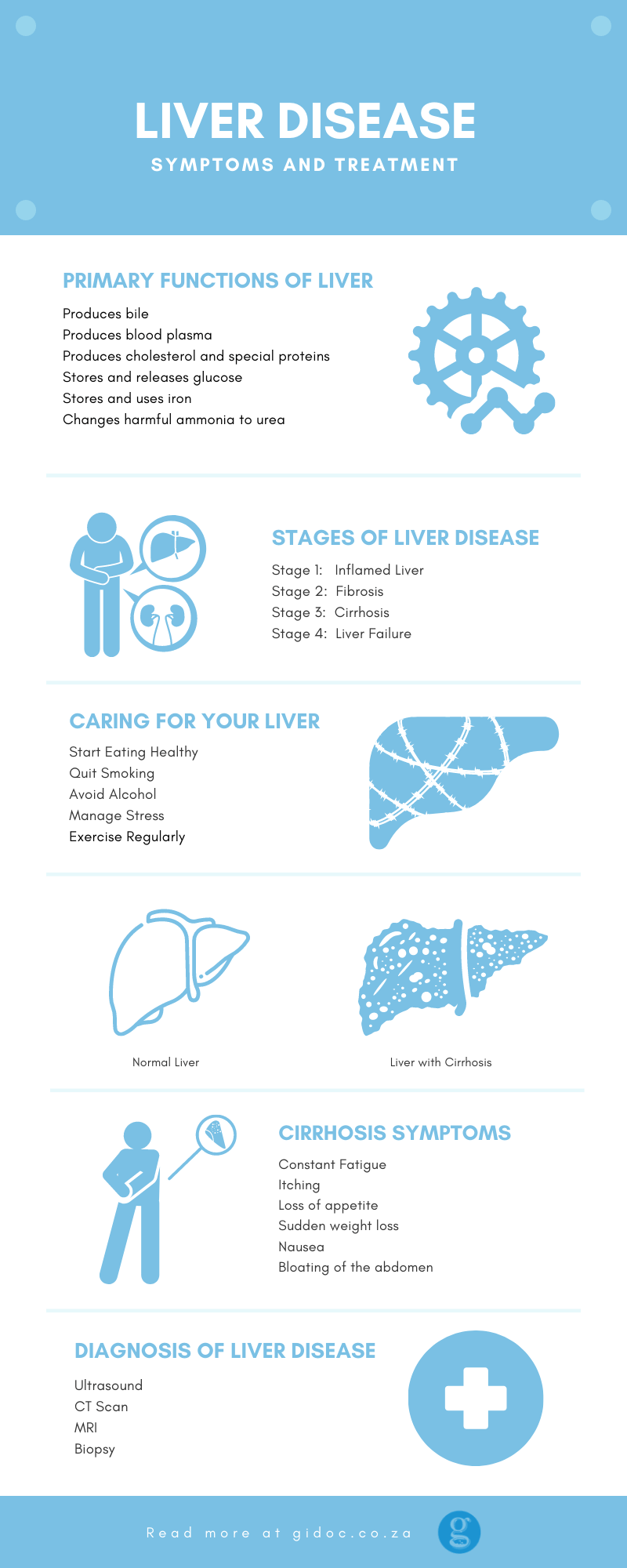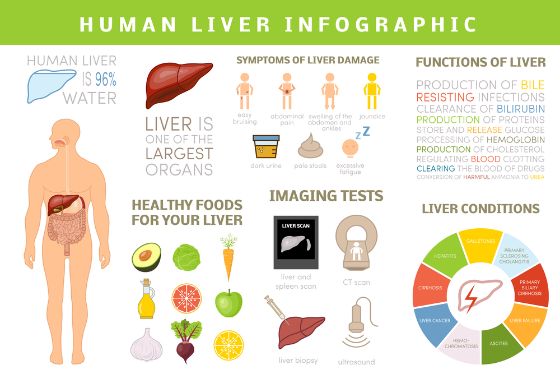The liver is one of the most important organs in our bodies with a key role in digesting food and getting rid of toxic substances.
This is why liver failure is one of the worst conditions you can have.
It compromises your immune system, causes deterioration of brain functions, may lead to kidney failure, and, in many cases, even death.
The good news is a liver disease can be prevented by simple lifestyle changes. Liver disease can also be successfully treated with early detection and proper medical intervention.

Anatomy of the Liver
The liver is known as the second-largest organ in the body. An adult’s liver can weigh approximately 3 pounds and can be as large as a football.
It’s reddish-brown in color and sits just under your rib cage on the right side of your abdomen.
The liver is divided into two sections, the right and left lobes.
The right lobe receives blood primarily from the intestine while the left lobe receives blood coming from the stomach and the spleen.
Both lobes are made up of 8 segments which are comprised of a thousand small lobes called “lobules”.
These lobules connect to a network of small ducts (tubes) that also connect with larger ducts to ultimately form the network of the hepatic duct.
Bile, a clear yellow or orange fluid produced by the liver to help break down fats and digest food, passes through the hepatic duct down to the gallbladder and the duodenum, the first section of the small intestine.
The Primary Functions of the Liver
The liver is a powerhouse that performs over 500 life-sustaining functions.
Its main function is to filter the blood coming from the digestive tract before it passes through the rest of your body.
The body cannot perform its metabolic processes without the liver. Nutrients cannot be absorbed by the body without the liver.
Even medicines cannot be broken down and be used by the body without passing through the liver.
Here is a list of the primary metabolic processes the liver performs:
1. Produces bile, which helps carry away waste products and break down fats to prepare them for further digestion and absorption
2. Produces blood plasma from certain proteins. Blood plasma carries nutrients, hormones, water, salts, enzymes, and proteins to different body parts. Cells also deposit their waste into the plasma
3. Produces cholesterol and special proteins to transport fats through the body
4. Stores and releases glucose as the body needs it
5. Stores and uses iron from processing hemoglobin
6. Changes harmful ammonia to urea to be excreted through urine
7. Filters the blood of medicines and other toxic substances.
8. Regulates blood clotting.
9. Produces immune factors and removes bacteria from the bloodstream to help the body fight infections.
10. Clears blood from bilirubin, a compound that causes the skin and eyes to turn yellowish when it reaches higher-than-average levels.

Liver Disease: Stages, Diagnosis, and Treatment
The liver has amazing abilities to self-repair. In fact, it is the only organ in the body that can grow back after parts of it were removed or damaged.
However, repetitive abuse may lead to liver failure and even death.
Liver disease is caused by a variety of factors – genetics, viruses, or, most commonly, unhealthy lifestyle choices (e.g. alcoholism and obesity).
Over time, these conditions may lead to the scarring of the liver (cirrhosis), which can lead to liver failure.
Detecting liver disease in its early stages increases the chances of reversing the damage, so it’s important to know what symptoms to watch out for.

4 Stages of Liver Disease
There are different kinds of liver disease but with any liver disease, the symptoms and liver damage will progress in a similar way.
STAGE 1: An Inflamed Liver
Having an enlarged or inflamed liver is a sign that your immune system is responding to foreign substances (i.e. toxins) in the body.
There could be excess fats, too many toxins, or a viral infection that is causing your liver to swell up.
A non-alcoholic fatty liver, a fatty liver, liver hepatitis, viral hepatitis, or autoimmune hepatitis, are some of the conditions that may bring about an inflamed liver.
A patient with an inflamed liver reports stomach pain or a burning sensation at the upper right area of the abdomen; however, in some cases of non-alcoholic fatty liver, there will be no symptom of inflammation at all.
See your Gastroenterologist immediately if you have felt any sign of liver damage. Treating your liver at this stage can help reverse liver damage.
STAGE 2: Fibrosis – The Start of Liver Scarring
If the liver is left inflamed, fibrosis will take place. Fibrosis is the process where scarring in the liver starts due to constant inflammation.
The scar tissues will replace healthy liver tissues and will eventually reduce liver function.
The scar tissues will also cause toxins and fat to continually build up and in turn block blood to flow to the organ.
At this stage, you’ll still have a chance to save your liver through medication and lifestyle management.

STAGE 3: Cirrhosis – Most Severe Scarring
Not treating fibrosis will lead to the development of cirrhosis, which is a severe scarring of the liver.
At this stage, the liver can no longer heal itself and thus may lead to many complications including cancer.
Here are some of the symptoms or complications:
- Constant fatigue
- Itching
- Loss of appetite
- Sudden weight loss
- Nausea
- Bloating of the abdomen
- Edema or swelling due to a build-up of fluid in the feet, ankles, or legs
- Spider-like blood vessels found on the skin
- Jaundice – yellowing of the skin and eyes
The treatment of liver disease done at this stage is to control the progress of scarring, as well as dealing with any complications and symptoms that may arise from cirrhosis.
STAGE 4: Liver Failure
Unfortunately, at this stage, your liver has lost all its ability to function, making it unable to heal.
Your physician will immediately give you medical attention to salvage what is left of your liver; but if this is no longer possible, the only remaining option is to have a liver transplant.
Diagnosis of Liver Disease
If you have been experiencing any of the previously mentioned symptoms, it’s crucial to schedule an appointment with a doctor as soon as possible.
A thorough examination of your health history and physical examination will help find the cause and extent of liver damage.
Your doctor may ask you to undergo several liver function tests through blood extraction.
Other blood tests might also be done to look for specific liver problems or genetic conditions.
Imaging tests such as ultrasound, CT scan, and MRI might also be recommended to show liver damage.
A biopsy (removal of a tissue sample from your liver) might also be conducted to further look for signs of liver disease or liver damage.

How to Care for Your Liver
Lifestyle changes cannot reverse cirrhosis but they can help to delay or stop the progression of liver disease and help prevent further complications.
Here are some of the lifestyle changes that can help you care for your liver while it’s not yet too late:
1. Start Eating Healthy
It all starts and ends in nutrition. Eat a balanced and healthy diet, limit your consumption of processed foods, detoxify your system by staying hydrated, and avoid sugary and salty food.
2. Quit Smoking
Cigarettes contain a host of toxins that can pose a serious toll on the health of your liver as the liver is the primary organ that filters toxins from our blood.
3. Avoid Drinking Alcohol
Alcohol is your liver’s worst enemy. Constant consumption of alcohol above the recommended limit can lead to severe liver damage or failure.
4. Manage Stress
Not many realize that stress can affect one’s overall health. Stress is like toxins not just to our mind but also to our organs. To make your liver healthy again, make sure to avoid getting stressed or find effective stress management techniques.
5. Regularly Exercise
Regular exercising and maintaining a healthy body weight lowers the chance of fat accumulation in the liver.
Our liver is one of the hardest working organs in our body as it works overtime to rid our bodies of toxins.
Maintaining a healthy lifestyle and seeking medical advice as soon as symptoms of liver damage occur are keys to keeping our livers healthy well into our senior years.
DISCLAIMER: PLEASE READ CAREFULLY
The information on this website is to provide general guidance. In no way does any of the information provided reflect definitive medical advice and self-diagnoses should not be made based on information obtained online. It is important to consult a Gastroenterologist or medical doctor regarding ANY and ALL symptoms or signs including, but not limited to: abdominal pain, haemorrhoids or anal / rectal bleeding as it may a sign of a serious illness or condition. A thorough consultation and examination should ALWAYS be performed for an accurate diagnosis and treatment plan. Be sure to call a physician or call our office today and schedule a consultation.
© Dr. Eduan Deetlefs, Registered Gastroenterologist, GI Doc Cape Town
Our website information is not intended or implied to be a substitute for professional medical advice, diagnosis or treatment. Please consult a doctor about your specific condition. Only a trained physician can determine an accurate diagnosis and proper treatment.


